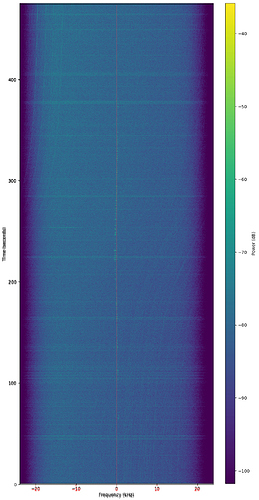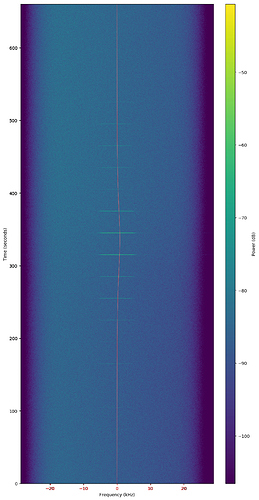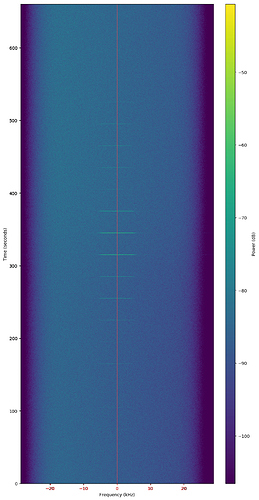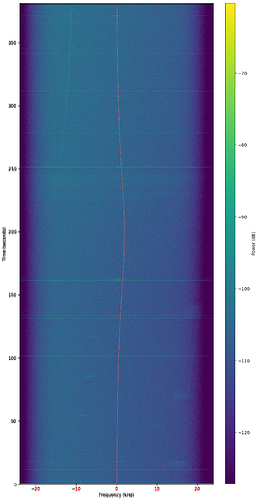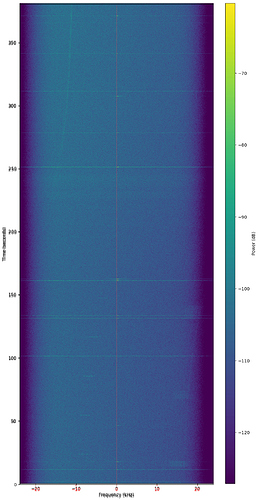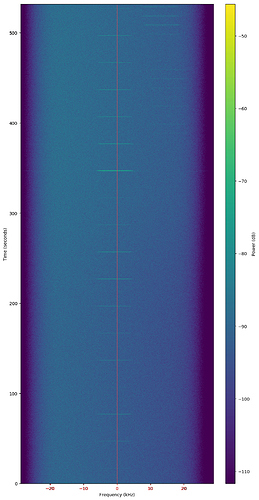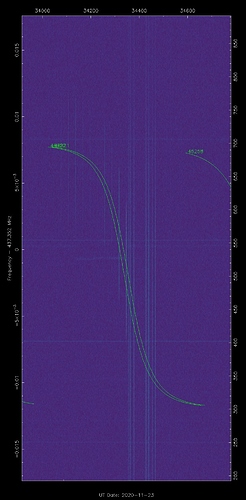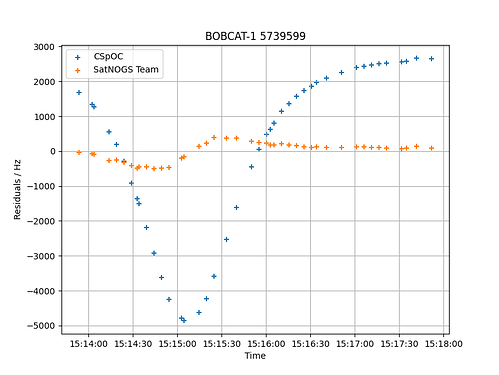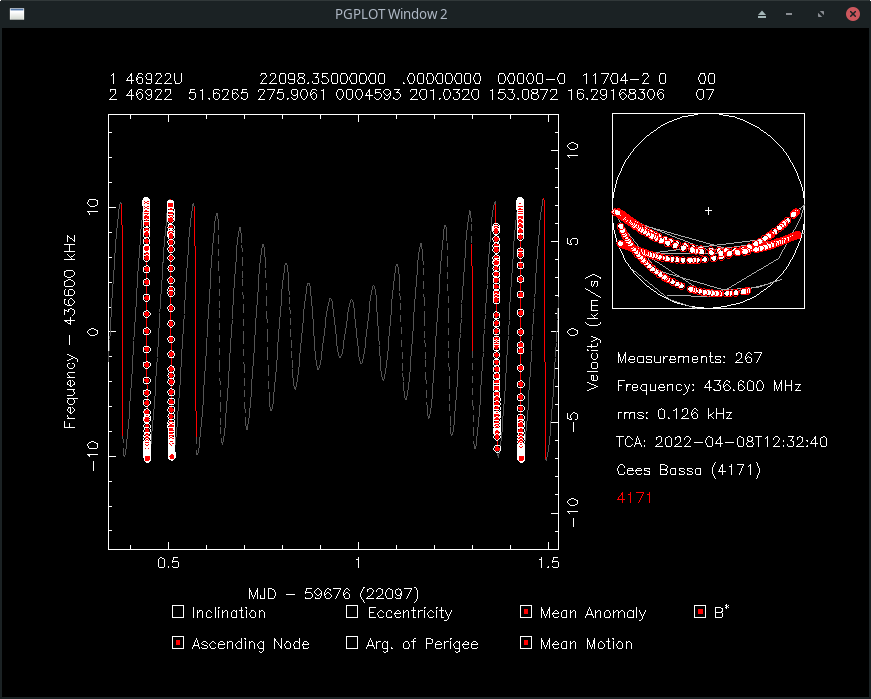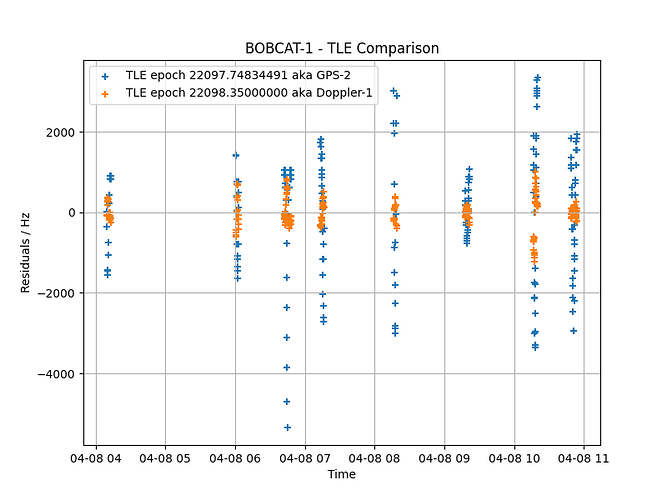If anyone would like a small sample of the 57k6 downlink from Bobcat-1 for testing, I have put a 50m RAW I/Q file (sample rate = 250k) at https://www.qsl.net/k/k4kdr//iq/bobcat-1--57k6/ along with files that contain the resulting decode
New TLE for Bobcat-1:
0 Bobcat-1
1 99837U 20321.20833333 .00000000 00000-0 27781-4 0 01
2 99837 51.6471 316.2292 0001734 104.8542 39.6275 15.50265711 01
New TLE set for SPOC:
SPOC
1 99792U 20321.20833333 .00000000 00000-0 27781-4 0 01
2 99792 51.6471 315.4949 0001758 107.7134 37.7221 15.50386959 04
Spacetrack has published TLE for this deployment. The first batch were marked as “To Be Assigned” and SPOC and Bobcat-1 fitted OBJECT RU (46924), this is why in some observations in Network we followed this set for these satellites. However some hours ago, the finalized TLE sets has been announced, and this is the current status:
- Bobcat-1: signals fit both 46921 and 46922, we follow 46921 in DB
- SPOC: signals fit both 46921 and 46922, we follow 46922 in DB
- NEUTRON-1: no signals (except some short transmissions that haven’t been identified to belong to the satellite), we follow 46923 in DB as suggested by spacetrack
- SATLLA-1: no signals, we follow 46927 in DB as suggested by spacetrack
- DESCENT: no signals, we follow 46925 in DB as suggested by spacetrack
PS “follow in DB” means that we haven’t yet identified the satellite but we think that is described by this TLE set we follow. Change from temporary NORAD IDs happens only after identification that can happen by two different ways:
- Observations that show that the satellite follows that NORAD ID with near to absolute certainty
- Identification of all the other satellites of the same deployment with the 1st method, so the remaining NORAD ID is the satellite.
Hello,
As we keep (hopelessly) listening for QARMAN, we received some beacons from SPOC (transmitting AX.25 header “from MOCI-1 to COSMO”, I guess it is SPOC). Is there anybody here from the team who would be interested by the data?
Some more updates from the latest observations:
- Bobcat-1: signals fit both 46921 and 46922, we follow 46922 in DB
- SPOC: signals fit both 46921 and 46922, we follow 46921 in DB
Above, it is changed which object is followed for each satellite in DB, more specifically they were swapped due to my latest analysis bellow. As the tool I used for the analysis is not fully accurate, I would like to wait a couple more days to be sure before we identify the satellites, except if other more accurate methods confirm the result.
Observation 3173336 for Bobcat-1:
| TLE 46921 | TLE 46922 |
|---|---|
Observation 3163911 for SPOC:
| TLE 46921 | TLE 46922 |
|---|---|
Good news, everyone!
@spacemig let us know in the SatNOGS chat room that the NEUTRON-1 team managed to decode (partially) and identified the AX.25 header call sign and a few more bytes of signals from SatNOGS observations. So, NEUTRON-1 is still alive and scenarios about antenna deployment failure or about dead battery are not valid any more.
As @spacemig described:
This confirms that we are entering a strange mode where we only beacon a couple times a day like we suspected. We just need to continue to patiently collect more observations and find the right opportunity to send some commands to change its behaviour.
We are going to schedule several observations in Network the next days to help the team and make sure that will identify the satellite before the objects separate too much.
Some quick updates:
Most recent observations confirm the result of Bobcat-1 following 46922 and SPOC following 46921.
We are going to wait some more days with more observations to identify them, until then we still have them set to follow these NORAD IDs in DB.
On other news we had one more confirmation by JA0CAW that NEUTRON-1 is alive:
From further analysis with ikhnos and with strf toolkit by @pierros :
- Bobcat-1: is identified as OBJECT RS(46922)
- SPOC: is identified as OBJECT RR(46921)
Please note that currently spacetrack shares TLE with wrong identification (they have swapped the NORAD IDs). Hopefully the next days, it will be fixed there too.
Observation 3186600 for Bobcat-1:
| TLE 46921 | TLE 46922 |
|---|---|
Observation 3188789 for SPOC:
| TLE 46921 | TLE 46922 |
|---|---|
Latest analysis from PA0DLO also confirms this identification:
NEUTRON-1 is still transmitting.
https://network.satnogs.org/observations/3186869/ with a demodulated frame.
https://network.satnogs.org/observations/3186865/
and also JA0CAW reported frame received by VK2DWT:
Using ikhnos, it looks like that TLE set of 46923 is the right one to follow, but we need more observations to confirm any identification.
Some more successful observations of NEUTRON-1 with 1 decoded frame:
https://network.satnogs.org/observations/3197221/
https://network.satnogs.org/observations/3197103/
https://network.satnogs.org/observations/3197109/
From the observations above and using ikhnos:
- NEUTRON-1: is identified as OBJECT RT(46923)
Neutron-1 with new sinous antenna without lna and rtlsdr.
After the tweet bellow by Scott:
and some searching and analyzing the same signal in network caught and decoded by 310 - CSPD-VA3TZA station, there was a hint, a good fit of the TLE assigned by third party services as DESCENT, that this is actually DESCENT satellite, which was never heard by SatNOGS before. Unfortunately the default(?) EARTH to SPACE frame like the one bellow wasn’t helpful to confirm this identification:
Audio input level is too high. Reduce so most stations are around 50.
[0.5] EARTH>SPACE:P��<0x00><0x1a>��<0x1d><0x00><0x00><0x00><0x1d><0x08><0x02><0x00><0x16><0x10><0x03><0x19><0x01>(<0x19>@�<0x00>� <0x08><0x02><0x00>� <0x08>"<0x00>� ��<0x00><0x00><0x06>"
------
U frame UI: p/f=0, No layer 3 protocol implemented., length = 61
dest SPACE 0 c/r=0 res=3 last=0
source EARTH 0 c/r=0 res=3 last=1
000: a6 a0 82 86 8a 40 60 8a 82 a4 a8 90 40 61 03 f0 .....@`.....@a..
010: 50 a7 ca 00 1a cf fc 1d 00 00 00 1d 08 02 c2 9c P...............
020: 00 16 10 03 19 01 28 19 40 b7 00 80 20 08 02 00 ......(.@... ...
030: 80 20 08 22 00 80 20 aa 81 00 00 06 22 . .".. ....."
------
I’ve scheduled a couple of observations above station near and in Canada as the satellite is supposed to transmit over Canada. We managed to get several similar frames, making our hypothesis that this was DESCENT a little stronger.
Earlier today I’ve decoded the frame bellow with the help of direwolf using this observation scheduled by PA5OXW on 2098 - PA5OXW Yagi Test station:
Audio input level is too high. Reduce so most stations are around 50.
[0.5] VE0DES>VA3YUG:P��<0x00><0x1a>��<0x1d><0x00><0x00><0x00>=<0x08><0x02>�<0x0e><0x00>6<0x10><0x03><0x19><0x02>(<0x1a>.�<0x01><0x00>8<0x13>s�<0x00>�H:<0x05>6�[<0x19>EQ�$~<0x08>BX<0x02>@<0x02>8<0x00><0x00><0x05><0x08><0x00><0x00>UP<0x00><0x00><0x00><0x00><0x00><0x00><0x00><0x20><0x00><f<0x00><0x00><0x0b>�
------
U frame UI: p/f=0, No layer 3 protocol implemented., length = 93
dest VA3YUG 0 c/r=0 res=3 last=0
source VE0DES 0 c/r=0 res=3 last=1
000: ac 82 66 b2 aa 8e 60 ac 8a 60 88 8a a6 61 03 f0 ..f...`..`...a..
010: 50 a7 ca 00 1a cf fc 1d 00 00 00 3d 08 02 c0 0e P..........=....
020: 00 36 10 03 19 02 28 1a 2e dd 01 00 38 13 73 80 .6....(.....8.s.
030: 00 e5 48 3a 05 36 ec 84 5b 19 45 51 c0 24 7e 08 ..H:.6..[.EQ.$~.
040: 42 58 02 40 02 38 00 00 05 08 00 00 55 50 00 00 BX.@.8......UP..
050: 00 00 00 00 00 20 00 3c 66 00 00 0b d8 ..... .<f....
------
While VE0DES is not a known or advertised callsign (if anyone can find any info, please let us know), the VA3YUG callsign belongs to York University that is behind the DESCENT mission. Decoding some more observations on the same day, got a couple more similar frames, helping to confirm the TLE fit and the identification of DESCENT as OBJECT 98067RX (46927). Interesting part, the reception was done over Europe in all cases, and the frame is not similar to the initial ones we received, but I’m 99% sure that they came from the same satellite as they both fit the same OBJECT at the same frequency. Would be interesting to know why/how the frame format changed.
I’ve scheduled a couple more observations to check if DESCENT is still transmitting. Let’s see…
They might have just fixed the callsign setup…
New TLE set for Bobcat-1. Given that the satellite reaches its re-entry and TLE sets are not produced too often, @cgbsat using the data from the satellite’s gps generated the TLE bellow. Have in mind that these TLE may change fast so don’t schedule too far in the future.
Bobcat-1
1 46922S 20500A 22097.49834491 .00000000 00000-0 15544-2 0 06
2 46922 51.6252 280.5691 0011863 271.4576 137.5145 16.20886298 04
In the first picture we have the position using the TLE set by spacetrack as object 46922 and as object 99999 the position using the TLE set above by @cgbsat:
Latest observation shows a great improvement of fit between the old CSpoC TLE and the new GPS-based:
One more TLE set by @cgbsat:
Bobcat-1
1 46922S 98067RS 22097.74834491 .00000000 00000-0 15079-2 0 00
2 46922 51.6268 279.1917 0011546 272.3191 157.3718 16.22855144 01
Updated TLE for the last orbits of Bobcat-1 by @cgbsat:
Bobcat-1
1 46922U 22098.35000000 .00000000 00000-0 11704-2 0 00
2 46922 51.6265 275.9061 0004593 201.0320 153.0872 16.29168306 07
We are waiting for some passes above Europe to add some more points and improve the TLE above.
Improvement from the new TLE can be seen clearly:
Doppler Measurements extracted from those observations:
751513, 751522, 751520, 753195, 752786, 748748, 754439, 753205
edit 2023-02-02: Observation IDs given here are missing the most-significant digit (5), e.g. 751513 is obs 5751513
Here are the latest TLE by @cgbsat:
Bobcat-1
1 46922U 22098.49000000 .00000000 00000-0 20000-2 0 04
2 46922 51.6265 275.0856 0008740 285.5958 170.6662 16.31784889 07
